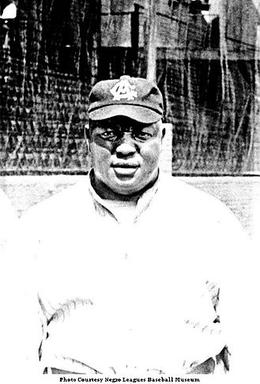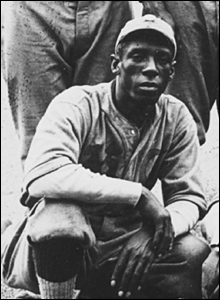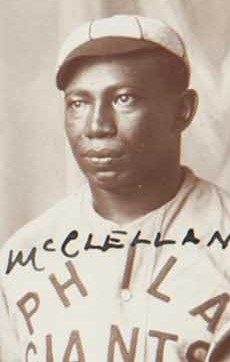
Andrew "Rube" Foster was an American baseball player, manager, and executive in the Negro leagues. He was elected to the Baseball Hall of Fame in 1981.
The Negro leagues were United States professional baseball leagues comprising teams of African Americans. The term may be used broadly to include professional black teams outside the leagues and it may be used narrowly for the seven relatively successful leagues beginning in 1920 that are sometimes termed "Negro Major Leagues".

Oscar McKinley Charleston was an American center fielder and manager in Negro league baseball. Over his 43-year baseball career, Charleston played or managed with more than a dozen teams, including the Homestead Grays and the Pittsburgh Crawfords, Negro league baseball's leading teams in the 1930s. He also played nine winter seasons in Cuba and in numerous exhibition games against white major leaguers. He was inducted into the National Baseball Hall of Fame in 1976.
The first Negro National League (NNL) was one of the several Negro leagues that were established during the period in the United States when organized baseball was segregated. The league was formed in 1920 with former player Rube Foster as its president.

John Henry Lloyd, nicknamed "Pop" and "El Cuchara", was an American baseball shortstop and manager in the Negro leagues. During his 27-year career, he played for many teams and had a .343 batting average. Lloyd is considered to be the greatest shortstop in Negro league history, and he was inducted into the National Baseball Hall of Fame in 1977.
The Brooklyn Royal Giants were a professional Negro league baseball team based in Brooklyn, New York. Formed in 1905 by John Wilson Connor (1875–1926), owner of the Brooklyn Royal Cafe, the team initially played against white semi-pro teams. They were one of the prominent independent teams prior to World War I before organized league play began.
Grant U. "Home Run" Johnson was an American shortstop and second baseman in baseball's Negro leagues. In a career that spanned over 30 years, he played for many of the greatest teams of the deadball era and was one of the game's best power hitters. Born in Findlay, Ohio, he died at age 90 in Buffalo, New York.

José Colmenar del Valle Méndez was a Cuban right-handed pitcher and manager in baseball's Negro leagues. Born in Cárdenas, Matanzas, he died at age 43 in Havana. Known in Cuba as El Diamante Negro, he became a legend in his homeland. He was one of the first group of players elected to the Cuban Baseball Hall of Fame in 1939. He was elected to the National Baseball Hall of Fame and Museum in 2006.

The Hilldale Athletic Club were an American professional Negro league baseball team based in Darby, Pennsylvania, west of Philadelphia.
The Indianapolis ABCs were a Negro league baseball team that played both as an independent club and as a charter member of the first Negro National League (NNL). They claimed the western championship of black baseball in 1915 and 1916, and finished second in the 1922 NNL. Among their best players were Baseball Hall of Fame members Oscar Charleston, Biz Mackey, and Ben Taylor.

The Cuban X-Giants were a professional Negro league baseball team that played from 1896 to 1906. Originally most of the players were former Cuban Giants, or ex-Giants. Like the Cuban Giants, the original players were not Cuban. Edward B. Lamar Jr. served as business manager for the team.

King Solomon "Sol" White was an American professional baseball infielder, manager and executive, and one of the pioneers of the Negro leagues. An active sportswriter for many years, he wrote the first definitive history of black baseball in 1907. He was elected to the Baseball Hall of Fame in 2006.

The Leland Giants, originally the Chicago Union Giants, were a Negro league baseball team that competed independently during the first decade of the 20th century. The team was formed via a merge of the Chicago Unions and the Chicago Columbia Giants in 1901, and then split in 1910 to form the Chicago Giants and what would become known as the Chicago American Giants. The team was named after its owner and manager, Frank Leland.
The All Cubans were a team of Cuban professional baseball players that toured the United States during 1899 and 1902–05, playing against white semiprofessional and Negro league teams. The team was the first Latin American professional baseball team to tour the United States. As a racially integrated team, future major league players Armando Marsans and Rafael Almeida got their start in the United States on the team. The team was also a forerunner for later Negro league teams staffed by Latin American players, such as the Cuban Stars (West), the Cuban Stars (East), and the New York Cubans. Negro league stars Luis Bustamante and Carlos Morán started their American careers with the All Cubans.

William S. Monroe was an American infielder in baseball's Negro leagues. He was also known by the nickname of "Money." During a 19-year career from 1896 to 1914, he played on many of the greatest teams in black baseball. He was a good hitter and slick fielding third base and second baseman who was compared to major league star Jimmy Collins. Monroe played all four infield positions, but spent his prime seasons at third base and second base.

Daniel J. McClellan was an American baseball pitcher and manager who starred for top-tier independent black teams before the Negro National League was founded. His career began about 1903, and he continued as a playing manager and organizer of lesser teams well into the 1920s.

George "Chappie" Johnson Jr. was an American baseball catcher and field manager in the Negro leagues. He played for many successful teams from 1895 to 1920 and he crossed racial boundaries as a teacher and coach.
The American Series was the name given to the exhibition baseball games played between Cuban and American teams in Cuba. Before the Cuban Revolution, American teams would regularly travel to Cuba and play various professional, all-star and/or amateur Cuban teams throughout the country. The series usually took place either in the fall, after the end of the American season, or during spring training before the season began. The first American Series took place in 1879, with then minor league Worcester team going 2–0 against its Cuban opponents.
The National Association of Colored Baseball Clubs of the United States and Cuba was an early professional Negro baseball league that operated on the East Coast of the United States from 1907 to 1910.













